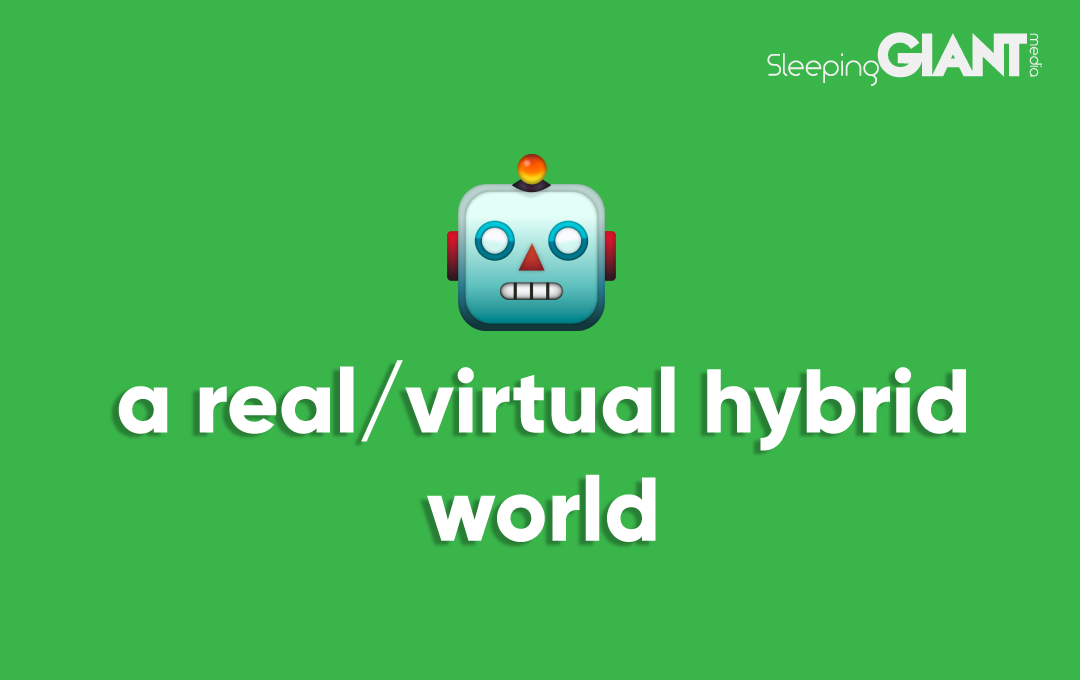
How can we take our learnings from a year of pandemic business, and apply it to make a real/virtual hybrid world, work for us?
The challenges of the pandemic throughout last year and likely into this year have held a spotlight on business practices that we used to take for granted – as well as glaring inefficiencies in entrenched processes.
If anything positive is to come out of the pandemic, it’s that the inevitable march to digital has had to become an Olympic sprint. The fastest companies to get to digital have a significant edge over the competition because it’s the difference between being able to trade or not. And, sure, the ability to rely on Furlough is great, but it means your employees are earning 20% less than they would be and you’re not able to have any income.
But this doesn’t mean that we’ll all suddenly work from mind-chips in an entirely virtual world – at least not for a while – and, more pragmatically, there are benefits to getting together to work and doing things manually. So the real question is, how do we go about planning for a real-world/virtual hybrid? How will we get on post-pandemic in a new world?
To answer that, we need to first look at what we’ve learned from last year.
What have we learned from Covid-19?
The clearest, most immediate lesson from the beginning of the pandemic was that businesses who were equipped to work remotely were able to keep running. Anticipating potential fallout from Brexit, we trialled a work-from-home period in 2019 to great effect. It allowed us to iron out certain kinks before they were business-critical.
So when it came to the pandemic growing at a worrying rate at the beginning of last year, we started working from home weeks before it was mandatory. This helped to protect the health of our staff as well as figure out solutions to new problems. Long-term working from home is significantly different than a short, two-week crisis caused by some port closure, road closure, or other event.
As such, it quickly became clear that we didn’t need three office floors. We’ve worked hard to foster a unique company culture and being in an office together has been a huge contributing factor to the success of our culture, but we don’t necessarily need a huge office to be able to get together. (although we’re very much keeping the office, just reimagining the space to be more reflective of the new world!)
I’m sure we weren’t alone in that realisation.
The massive shift to working from home has given workers much more free time, has allowed more flexible working, and means businesses can save on often-extortionate rents.
The other, glaring lesson is the importance of time and time management. Optimising decision-making processes, as well as processes large and small, frees up a huge amount of time to be productive elsewhere.
It’s important to set aside time for socialising and team building, but if you’re spending an hour on a 20-minute meeting, then you’re going to get behind really quickly.
Ultimately, these changes have allowed us to be agile enough to stay afloat, and that’s made all the difference. But it hasn’t just been us. Clients of ours who have previously relied primarily on non-digital processes and manual handling at various business levels have struggled significantly.
Some of these are unavoidable – the hospitality and travel industries have been severely hit – but some have been effected through a reluctance to make a significant transition to digital.
It’s understandable when a process works, why change it? But when a process could work much more effectively, why not change it?
So the real question here remains: if going digital is inevitable, how do we prepare for a significantly more digital business world? How do we plan for a real-life virtual world?
How to plan for a hybrid future post-pandemic…
Don’t be afraid of automation
Firstly, don’t be afraid of automation. The more time you can free up from mundane tasks, the more time you have to spend on the aspects of work that require the human touch: the human side of HR, the creative side of ad creation & targeting, the customer relations side of sales, and so on.
Don’t use automation to get rid of your workforce, use automation to free up your workforce for productivity that they’re especially suited for.
Optimise processes
This is perhaps easier said than done but taking a step back and really analysing how different business processes function can give you the chance to spot problems. Even just writing out the process in a clear flow chart can help to spot unnecessary blockers.
Let’s take the ability of an employee to give a discount on an item of furniture, for example:
Customer asks for discount → employee fetches line manager → line manager must then assess why a discount is being given (will it improve chances of a large-gross sale? Is the product actually faulty? Does the customer have some sort of loyalty card? etc.) → Line manager then instructs the employee how to proceed.
A sale is made, or it isn’t.
Either way, this process ends up taking a significant portion of the line manager’s time away from things that they could be doing, all in order to micro-manage things that they don’t necessarily need to micro-manage.
A large part of process optimisation lies with empowering staff to make business positive decisions without needing to constantly check in with managerial staff.
Digitise everything that can be digitised
Now, empowering staff to make decisions that affect the business means that you may have staff making the wrong decisions. In theory, if these decisions are within frameworks that make sense then the decision shouldn’t be wrong. But let’s continue with the example of a member of retail staff who is now able to decide on when to give discounts – the primary worry would be that the member of staff now starts giving discounts to everyone.
In a solid process framework, the member of staff would be aware that they should only be giving, say, two or three discounts a week when it’s going to significantly sway a sale or non-sale. But if you track these with paper receipts and an analogue till, you simply can’t track whether your staff are sticking to these guidelines.
Digitising your till systems and your communications lets you stay on top of when actions are being taken, by whom, and find out why.
It also lets you track things like seasonal ups and downs in sales, expenditure, wages, and so on, without some poor sod having to go through stacks of data manually to make a pretty graph.
Things like project management can also be digitised using any one of the project management tools currently available. Being able to have multiple team members quickly see what the plan is, which tasks need to be done, when, who’s doing them, how far they are, etc. means that you save a lot of time having to re-explain what’s going on.
Use an office space for the human things
All this isn’t to say that office spaces have become obsolete. It’s just that we don’t need to rely on office spaces for everything. If staff can reliably work from home (or holiday!) while maintaining internal and external communication, then you can repurpose your office space for the things that do need to be done in person.
An office space is great for things like workplace socialising, hotdesking, converting areas into film zones for promotional videos, in-person training, hosting important client meetings and events, or anything else you can think of.
If a team has a particularly crucial project happening, then let them book a few adjacent desks or a meeting room for the day to hash out everything that needs to be hashed out.
Crucially, using an office space as a hub rather than a vault gives you and your staff more flexibility.
Consider hybridising retail
What’s starkly clear is that having a solid, attractive, and easily-navigable website makes a huge difference. Regardless of whether you’re a retail company or a welder, making sure that people can find you online, know what you sell, and how to buy it, will give you a real edge.
But this isn’t terribly new.
Retail, however, has still held onto the MO that you need to have stock in-store in order to sell it. Perhaps people simply like to be able to walk into a shop and immediately get something. But a hybridised future also provides the possibility of not having to store all of your stock in each outlet.
For example, a shop can be used in a similar way to a display room. Having only a few of each item available for sale in-store means your staff don’t have to spend as much time unpacking and shelving goods.
Instead, you can display your goods in order to tell a story; you also free up space to display a larger variety of items and offer some sort of included home-delivery with the price.
This means you can maximise shop space to display items more effectively and utilise a robust website to order items for your customers.
More importantly, you making this digital means you can now develop a lasting digital relationship with your customers. Sending their receipts via email, for example, gives them the opportunity to opt-in to future contact.
This is something that used to take significant resources but is now a button-click.
And this seems to be the crux of hybridising business practice between virtual and real-world elements: figure out what takes a large number of your resources, and assess how those resources could be saved through digital methods.
If you’re serious about staying in the race, you’ll notice that soon enough, with steady digital investment and process optimisation, you’ll be running ahead.
If you need any help with getting customers from digital channels, get in touch with us.
Blog
Everything you Need to Know About the March Core Update
We knew it wouldn’t be long before Google released their first core update of...
Giant Wednesday
How To Optimise Images For Websites
Digital Marketing, technology & business insights, how-to's and explainer...
Follow Us
Sign Up For More
Stay up to date with the latest happenings, learnings, events & more with our GIANT Newsletters.
Contact Us
Top Floor, The Civic Centre, Castle Hill Avenue, Folkestone CT20 2QY.
Copyright © 2021 Sleeping Giant Media. All Rights Reserved.


